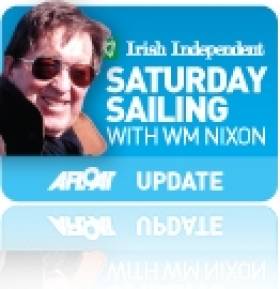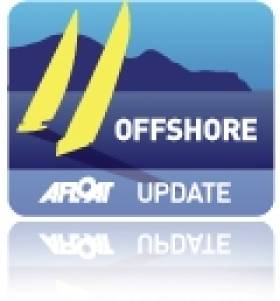Displaying items by tag: rolex
Ireland Hit The High Spot In The Sydney Hobart Race 23 Years Ago
#rshyr – Ireland's fascination with the Rolex Sydney-Hobart Race moved onto a new plane in 1991, when a three-boat Irish team team of all the talents had a runaway win in the Southern Cross Series which culminated with the 628-mile race to Hobart. The three skipper/helmsmen who led the squad to this famous victory twenty-three years ago were Harold Cudmore, Joe English and Gordon Maguire, all on top of their game.
These days, the incomparable Harold Cudmore is still a sailing legend, though mostly renowned now for his exceptional ability to get maximum performance out of large classics such as the 19 Metre Mariquita, sailing mainly in European waters.
But sadly, Joe English passed away just eight weeks ago in November in Cork, much mourned by many friends worldwide. Yet for Gordon Maguire, the experience of sailing at the top level in Australia was life-changing. He took to Australia in a big way, and Australia took to him as he built a professional sailing career. And he's still at it in the offshore racing game as keenly as ever, with 19 Sydney-Hobarts now logged, including two overall wins.
He raced the challenging course of this 70th 2014 edition as sailing master of the Carkeek 60 Ichi Ban, a boat which is still only 15 months old, having made a promising though not stellar debut in 2013's race. Also making a determined challenge was the First 40 Breakthrough with a strong Irish element in the crew led by Barry Hurley, fresh from the class win and second overall in October's Rolex Midde Sea Race.
And high profile Irish interest was also to be found aboard the Botin 65 Caro, the record breaker in the 2013 ARC Transatlantic Race. She's a very advanced German-built "racer/cruiser" aboard which Ian Moore - originally of Carrickfergus but longtime Solent-side resident - was sailing as navigator.
W M Nixon casts an eye back over the 2014 race, whose prize-giving took place in Hobart yesterday, and then concludes by taking us back to 1991, when Ireland moved top of the league in the Offshore Racing World Team Championship on the same occasion some 23 years ago.
It has to have been the most keenly-anticipated debut in recent world sailing at the top level. At last we'd get to see how Comanche could go in serious sailing. When the 70th 628-mile Rolex Sydney-Hobart Race started on Friday December 26th at 0200 hours our time, 1300 hrs local time in Sydney Harbour, this was for real. There may have been 117 boats of all shapes and sizes from 33ft to 100ft in the fleet. But all eyes were on the limit-pushing 100ft Comanche, skippered by the great Kenny Read. The world wanted to see how she would show what she could do when the chips were down, when the racing was straight line stuff, and when some serious offshore battling was in prospect instead of the inshore-hopping mini-test which had been seen in the Solas Big Boat Challenge in Sydney Harbour on December 9th.
In that, the well-tested Wild Oats XI, skippered by Mark Richards, had sailed a canny race to take the line honours win from the other hundred footers. But the majestic Comanche, owned by Jim Clark and his Australian wife Kristy Hinze Clark, had shown enough bursts of speed potential to raise the temperature as the start of the big one itself approached.
And in a brisk southerly at the start, Comanche didn't disappoint. She just zapped away from Wild Oats to lead by a clear 30 seconds and notch a record time at the first turning mark to take the fleet out of Sydney Harbour, and that dream debut was what made the instant headlines on the beginning of the 628–mile slog to Hobart.
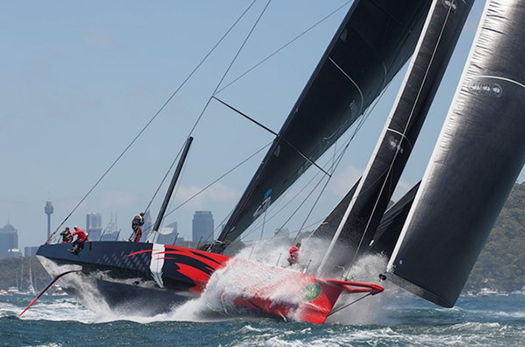
The moment of glory – the mighty Comanche roaring down Sydney Hobart at the start to log a record time to the first turning mark. Photo: Rolex/Daniel Forster
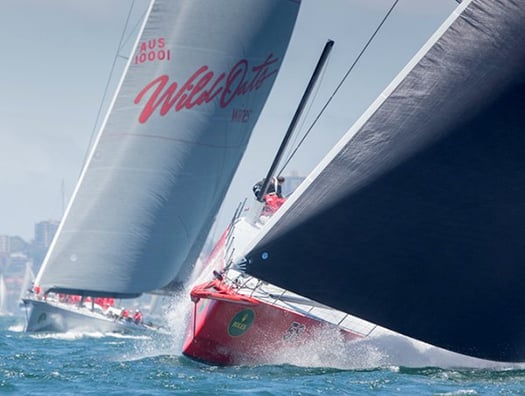
No two ways about it – Comanche is clear ahead of Wild Oats XI approaching the first mark. Photo: Rolex/Daniel Forster
But out at sea, with winds strengths varying but mostly from the south for the first day or so, different stories begin to emerge. A grand sunny southerly sailing breeze may provide lovely sailing and pure spectacle in Sydney Harbour. But get out into the Tasman Sea to head south for Hobart, and you find that the wayward south-going current – always a crucial factor in the early stages of the race to Hobart – can be going great guns and making mischief as a weather-going stream, kicking up a steep sea which can be boat-breaking when that last ounce of performance is being squeezed out.
And as previewed here on December 20th, up among the hundred-footers they've been pushing the envelope and then some in boat development and modification. In new boat terms, the mighty and notably beamy Comanche has gone about as far as they can go for now. But with the likes of the former Lahana reappearing as Rio 100 with a complete new rear half, and Syd Fischer's Ragamuffin 100 simply cutting away the hull for replacement with a complete new body unit while retaining the proven deck and rig, we're sailing right on the edge in terms of what the weird mixtures of new and old build can combine for combat when the seas are steep.
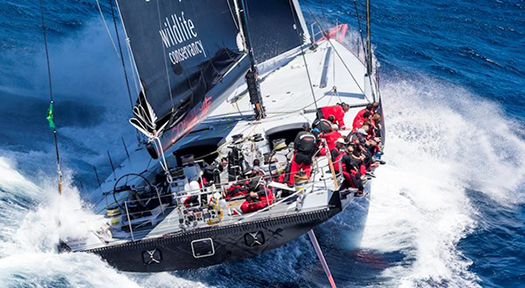
Comanche's wide beam gives added power when there's plenty of breeze......Photo: Rolex/Carlo Borlenghi
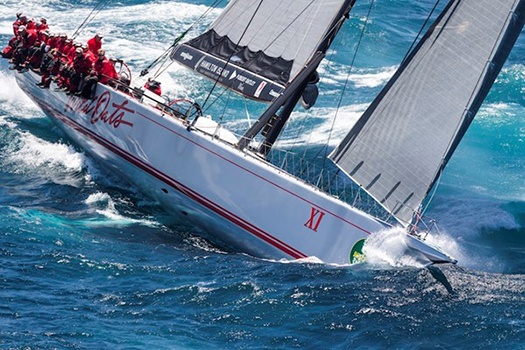
....but the narrow Wild Oats XI can be as slippery as an eel when the head seas get awkward, and when the wind eased she got through Comanche and into an extraordinary 40 mile lead on the water. Photo: Rolex/Carlo Borlenghi
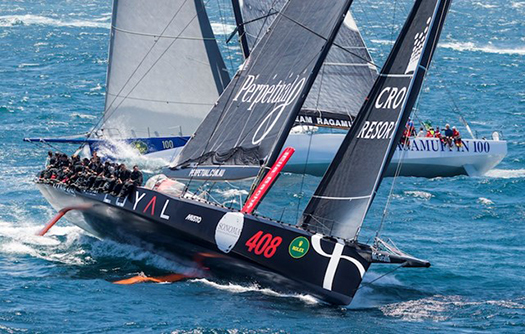
Not all boats revelled in the bone-shaking conditions of the first hundred miles of beating. Perpetual Loyal (foreground) had to pull out with hull damage possibly caused by an object in the water, but the irrepressible Syd Fischer's Ragamuffin 100 (beyond), with a completely new hull, continued going strong to the finish and was third in line honours Photo: Rolex/Carlo Borlenghi
But this glorious element of larger-than-life characters with boats that are off-the-wall is now an integral part of the RSHYR, which manages to attract an enormous amount of attention thanks to its placing in the midst of the dead of winter in the Northern Hemisphere, while in Australia much attention focuses on what is in effect an entire and familiar maritime community racing annually for the overall handicap prize.
Yet though the course is simple, it's deceptively so. Just because it's mainly a straight line from one harbour to another doesn't mean there aren't a zillion factors in play. And as the race gets so much attention, few offshore events of this length are so minutely analysed, and the first 24 hours provided a veritable laboratory for seeing the ways different boats behave in different wind and sea states with the breeze on the nose.
Thus Wild Oats XI has always had a formidable reputation for wiggling her exceptionally narrow hull to windward in awkward seas for all the world like a giant eel, and the early beating saw her doing that very thing, hanging in there neck and neck with Comanche. Despite her beamier hull, Comanche rates slightly lower than Wild Oats. But if a lull with its leftover sea arrived, her greater volume would become a liability to performance, whereas if the breeze got back to full strength, and particularly if it freed the two leaders, then Comanche would be firmly back in business.
But it was not be. Crossing the Bass Strait with Wild Oats right beside them, Comanche's crew saw their navigator Stan Honey emerge on deck and approach Kenny Read with a thoughtful expression on his face, and an ominous little slip of paper in his hand. It was the latest weather print-out, and it wasn't happy reading for a big wide boat that needs power in the breeze. Before expected brisk winds from the north set in, they'd to get through the lighter winds of an unexpectedly large and developing ridge.
Almost while they were still digesting this bit of bad news, Wild Oats started to cope much better with the lumpy leftover sea, and wriggled ahead of Comanche in her classic style. And the further she got ahead, the sooner she got into increasingly favourable wind pressure. As Read put it after the finish: "For twelve hours, conditions were perfect for Wild Oats, and they played a brilliant hand brilliantly".
Amazingly, the old Australian silver arrow opened out a clear lead of an incredible forty miles before conditions started to suit Comanche enough to start nibbling at this remarkable new margin. And fair play to the Read crew, at the finish they'd made such a comeback that Wild Oats was only something like 49 minutes ahead. But even with the new American boat's slightly lower rating, she was beaten on handicap too, and in the final rankings Wild Oats showed up as having line honours overall and a commendable 5th on IRC in Division 0 - and we shouldn't forget she won the overall handicap honours back in 2012 anyway.
But for 2014's race, for a while it looked as if it might be the Cookson 50s again for the overall win. But although last year's Tattersall's Cup winner, the Cookson 50 Victoire, at first took the Division 0 win with her sister-ship Pretty Fly III second, they were so close that when Pretty Fly got 13 minutes redress for an incident with the Ker 46 Patrice in mid-race, it reversed their placings.

It all came good in the end....after being initially placed second in Division 0, the ten-year-old Cookson 50 Pretty Fly III got 13 minutes of redress for an adverse incident during the race, and that bumped her up to the Division 0 win.
Either way, it was still Cookson 50s imprinted all over the sharp end of Division 0. But they were slipping in the overall rankings, where it was boats in the 40-45ft range which were settling into the best combination of timing and conditions to take the Tattersall's.
And plumb in the middle of them was the First 40 Breakthrough, with her strong Dublin Bay Sailing Club input from the Irish team led by Barry Hurley. Fortunes wax and wane with astonishing volatility as the Hobart race progresses, but gradually a pattern emerges. So though at one stage Breakthrough was showing up only around 30th overall, equally she'd a best show of third.
And all around her on the water were similarly-sized and similarly-rated boats with their race-hardened crews knowing that with every mile sailed and every weather forecast now fallen favourably into place, things were looking better and better for this group to provide the overall winner.
It was a very race-hardened crew which came out on top. It was way back in 1993 that Roger Hickman got his first Sydney Hobart Race overall win in an eight year old Farr 43 which was still called Wild Oats, as original owner Bob Oatley hadn't yet reclaimed the name for ever bigger Grand Prix racers. When he did start to go down that road, the 1985 Wild Oats became Wild Rose, but "Hicko" still owns her. And by the time the Rolex Sydney-Hobart Race 2014 started, he was doing it for the 38th time. He went into it as current Australian Offshore Champion, now he has won the big one on top of all that. Some man, some boat.
The slightly higher-rated Breakthrough was pacing with Wild Oats for much of the race, but as Barry Hurley's report for Afloat.ie told us with brutal honesty, somewhere some time they got off the pace. If you didn't know already of Barry's remarkable achievements - which include a class win in the single-handed Transatlantic Race and the more recent Middle Sea Race success – you would warm to the man anyway for the frankness of his initial analysis of why Breakthrough slipped from being a contender to 12th overall and – more painfully – down to 7th in their class of IRC Division 3.
He promises us more detailed thoughts on it in a few weeks time, something which will be of real value to everyone who races offshore, for the race to Hobart is a superb performance laboratory. And maybe we can also hope in due course for further thoughts from someone on whether or not Matt Allen's Carkeek 60 Ichi Ban, skippered by Gordon Maguire with Adrienne Cahalan as navigator, has what it takes to be a killer.
It's easy for us here in Ireland to look at screens of photos and figures and reckon that Ichi Ban is just a little bit too plump for her own good. But Maguire has twice been key to a Sydney-Hobart overall win, the most recent being in 2011 with Stephen Ainsworth's Loki. And Cahalan's record of success as a navigator/tactician is almost without parallel. Yet though Ichi Ban's 2014 Hobart race score of 8th in line honours and fourth in IRC Division 0 is a thoroughly competent result, it just lacks that little bit of stardust.
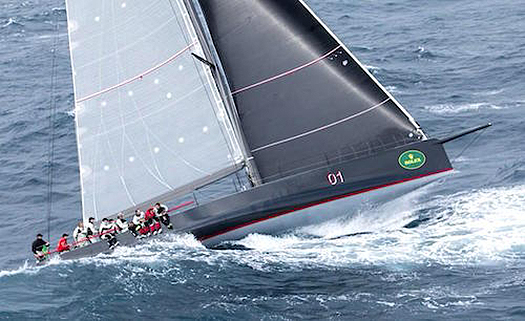
Ichi Ban finding her way through the waves on her way to Hobart. If that's not a spare tyre around her midriff, then what is it?
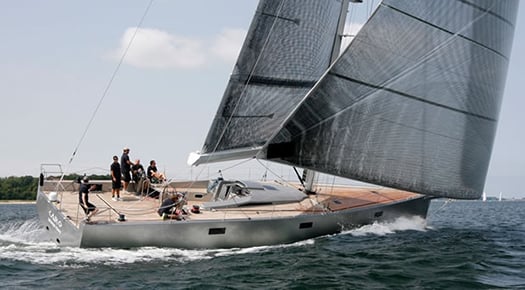
Despite being a "racer/cruiser", the Botin 65 Caro – navigated by Ian Moore – pipped Ichi Ban for third in class.
With the next Rolex Sydney-Hobart Race just over eleven months down the line, let's hope we're proven utterly wrong within the year on the Ichi Ban question. But the whole matter is pointed up by the fact that the boat which pipped in ahead of her in the IRC Div 0 placings in third place behind the two Cookson 50s was the Botin 65 Caro, with our own own Ian Moore navigating on this 65 footer which likes to emphasize her dual role as a racer-cruiser.
Now there really is food for thought. But in this first weekend of this wonderful new year of 2015, let's remember some of the events of December 1991 as recorded in excited detail in the Afloat magazine of Feb/March 1992.
On the cover is Meath-born John Storey's Sydney-based Farr 44 Atara, around which the Irish Southern Cross team of 1991 was built, as Harold Cudmore was aboard, and he brought out John Mulcahy from Kinsale and John Murphy from Crosshaven.
The small boat of the team was Tony Dunne's Davidson 36 Extension – the owner claimed Irishness through the Irish granny rule, but the matter was put beyond any doubt by Joe English being on board with Dan O'Grady and Conor O'Neill. And then for the third boat they'd Warren John's Davidson 40 Beyond Thunderdome, whose owner was happy to be Irish if they'd let him, and to put the matter beyond doubt his vessel was over-run by Howth men in the form of Gordon Maguire, Kieran Jameson, and Roger Cagney, with Dun Laoghaire's Mike O'Donnell allowed on board too, provided he behaved himself.

In the Southern Cross Series of 1991, the Davidson 40 Beyond Thunderdome was raced for Ireland by Gordon Maguire and Kieran Jameson. Thunderdome was top of the points table when she was knocked out with a dismasting in the final inshore race, and was unable to race to Hobart.
It was an accident-prone series, with Beyond Thunderdome dismasted in a tacking collision with one of the Australian boats with just three days to go to the start of the Hobart Race. There simply wasn't time to get a replacement mast, let alone tune it, but at the last minute the jury decided the Australian boat was at fault, and allowed Beyond Thunderdome average points not only for that race in which she'd been dismasted, but also for the Hobart Race which hadn't even yet been sailed.
In a final marvellous twist to the story, as Thunderdome couldn't race to Hobart, Gordon Maguire was drafted aboard Atara to add helming strength for the big one. Atara had only been a so-so performer until the big race. But Cudmore and Maguire – that really was the dream team. And it gave the dream result. Atara won the 1991 Sydney-Hobart race overall by a margin of one minute and 50 seconds. It was one of the closest results ever, but it was a close shave in the right direction for Ireland. The Irish party in Hobart to welcome 1992 was epic. And Gordon Maguire's sailing career was set on a stellar course.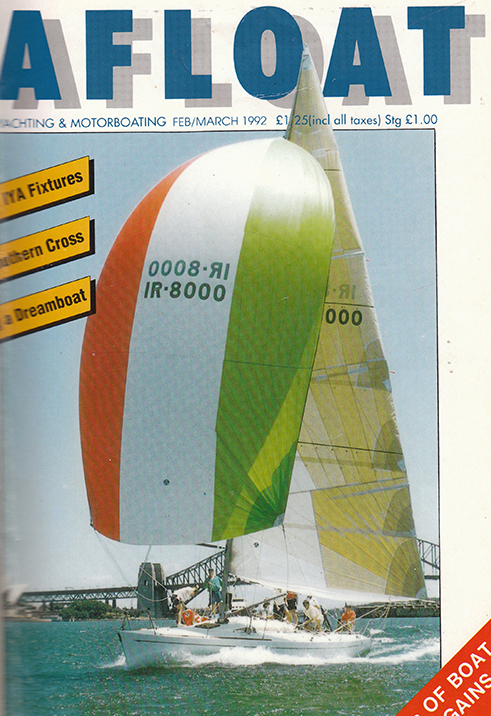
Our magazine edition of February/March 1992 cover-featured John Storey's Farr 44 Atara, overall winner of the 1991 Sydney-Hobart race with the dream team of Harold Cudmore and Gordon Maguire on board to give Ireland the win in the Southern Cross Series.
Sydney–Hobart Race: Breakthrough Under Radar is a Beau Geste
#rshyr – It is developing into one of the most complex Rolex Sydney-Hobart Races sailed in many a long day. And as it's in the upside-down Southern Hemisphere, weatherwise everything moves in different ways. W M Nixon isn't sure he has a clue what's going on, but he happily throws in his pennyworth to add to the confusion.
One surefire way to get publicity is to keep things secret, just releasing tasty bits of info at the last minute. With the Rolex Sydney-Hobart Race providing a focal point of sailing attention at a time when most of the world is being distracted by minor matters such as celebrating Christmas, or simply getting through midwinter storms, the opportunities to make a show-stopping impact are magnified.
A dearth of maritime stories at home makes the saltheads leap at anything of cheerful sailing interest. For there are only so many ways that you can report that ferries aren't sailing at all, or are delayed. If we never hear the phrase "operational reasons" again, it will be too soon. And sad and all as we are about the huge whale in Achill, we were too far away to do anything about it. But give us something like the sudden appearance of Karl Kwok's startling new 80ft Beau Geste in Sydney just a couple of days before the race to Hobart begins, or the news on Christmas Day that a First 40 formerly thought of as just another Australian boat is actually an Irish entry in disguise and slipped in under the radar, then we come to life.
Naturally there'd been plenty of stories circulating about the new Kwok boat. However, as the other serious biggies in the Hobart fleet began to strut their stuff around Sydney harbour through December, inevitably they hovered up the attention. But then on Sunday, out of the blue, Beau Geste sailed into Sydney after a crisp and very satisfying four day test passage across from New Zealand, which is cooking with gas
.
Anybody mind if we come in? The brand new 80ft Beau Geste arrives in Sydney on December 22nd after her speedy maiden voyage from New Zealand. Photo: Rolex/Carlo Borlenghi
You can understand the reluctance of skipper Gavin Brady and the rest of Karl Kwok's team to seek the limelight. The previous much-admired Farr-designed 80ft Beau Geste, winner of many trophies, had suddenly as near as dammit broken in two off Norfolk Island during the 2012 Auckland-Noumea Race. The good folk of Norfolk Island did their best to help out, as did ships and fishing boats in the neighbourhood, but to this day nobody is too sure how the big boat stayed afloat long enough to be got to port.
There they were, all the gear intact, but the hull a write-off. They say that when you're unhorsed you should get back in the saddle immediately if the horse isn't injured. But this was one terminally injured nag. So they did the next best thing. They went to designer Mareclino Botin, he who created the Volvo 70 Camper which was the most radically different of the generally similar Volvo flotilla last time round, and ordered up a new canting keel 80 footer with debut planned for the 2013 Sydney-Hobart Race.
Built by Cookson in Auckland with beefed up engineering by comparison with the previous boat, but carrying some of her gear, the new boat is of interest every which way, as Botin used to be in partnership with Shaun Carkeek, who has designed the much-fancied 60-footer Ichi Ban for Matt Allen. And you can see (or maybe imagine) certain distant style resemblances between the two boats. But as the new Kwok boat follows Botin's enthusiasm for having the mast well aft (it was so far aft in Camper it was astern of the canting keel), it wouldn't be an exaggeration to describe Beau Geste as a one-masted schooner, though no more so than Volvo 70s like Giacomo.
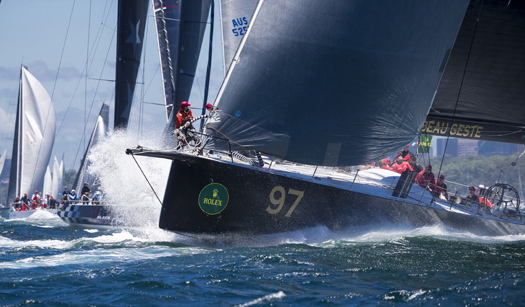
Baptism of fire. The Sydney-Hobart 2013 is Beau Geste's first race – she'd barely been afloat for a month when it started on Thursday. Photo: Rolex/Daniel Forster
Nevertheless, the first time this slightly offbeat boat had a crack at the opposition was in that initial crazy eight minute drag race down Sydney harbour at the start of the race to Hobart on Thursday. Of which more anon. But meanwhile, what's this about an Irish entry disguised as a bog standard Australian one?
Well, they sprang it on us all with perfect timing on Christmas morning. There in the entry list is Breakthrough, a First 40, a boat type always of high interest - when the design was new, back in 2010, two of them took first and second overall in the Rolex Sydney-Hobart Race.
It was a marketing dream for Beneteau, for each race to Hobart will always produce a particular set of conditions which will suit one boat type to a T. In 2010, it was the very new First 40 which hit the spot, coming forward to step into the very big shoes so capably filled for years by the marvellous First 40.7.
They may have got everything right, but circumstances conspired against the new First 40 being a runaway marketing success. Primarily, it was the global recession taking hold big time, particularly in Europe. But then too, there was still plenty of life in the First 40.7, with thriving class associations, and one design racing in events like Cowes Week.
Whatever, we've only seen two First 40s in Irish ownership since the design appeared, one in Baltimore and used for cruising, the other based in the Algarve. But now the good news is that Barry Hurley is actually the skipper of Breakthrough on the race to Hobart. It must be true, as you read it here on Afloat.ie on Christmas morning while talking to that fat white-bearded man in the red suit.....But enough. Even if the official CYCA listing suggests Mathew Vadas is the skipper, man in charge is Barry Hurley, already with two Hobart races notched, and with him he has brought Kenny Rumball, Keith Kiernan and Catherine Halpin, all of the Royal Irish YC, to sail in partnership with the Vadas team, and hoping to repeat that Hurley touch which brought a class win in the Middle Sea Race back in October.
As for the big boat start – well, it was eight minutes like we'd never seen before. Morning clouds had cleared to leave Sydney Harbour at its sparkling best in a brisk sou'easter, reaching start to the first mark, and the biggies went off first at max revs with Wild Oats and Perpetual LOYAL neck and neck for the lead, with Anthony Bell's Perpetual in the weather gauge.

The power of Perpetual LOYAL's hull is plain to see – but that power with its extensive wetted area comes at the expense of light weather performance. Photo: Rolex/Daniel Forster
But the "old" Wild Oats never ceases to surprise, or maybe Mark Richards and his crew know her so well that they can hit top performance while others are still winding up to it. They simply held Perpetual up above the line to the first mark until they were able to peel away for a short run to the turn which left enough of a gap between them and the big black boat to allow Beau Geste to nip in between in second place.
The abiding memory of that eight minute sprint was the way the different boats had sudden bursts of acceleration. You'd to keep reminding yourself that the smallest craft in this flotilla were 70ft Volvos, for all were having speed bursts like dinghies on the plane.
So that was interesting, but then as they started the beat south in open water, it became clear that Wild Oats with a reef in the main was holding on very nicely ahead of the supposedly more powerful Perpetual, while the smaller Beau Geste was sagging to lee. But then, schooners never could point high, whereas Wild Oats' pointing ability in a lumpy sea was a wonder to behold.
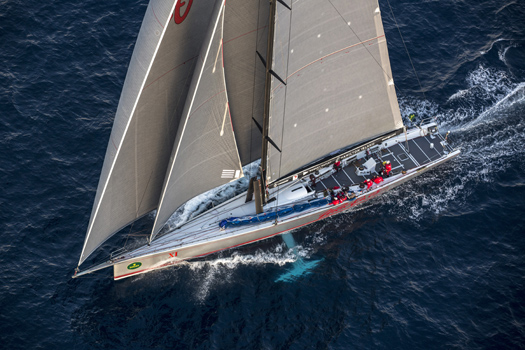
The skinny one....thanks to her slim hull, in the light airs on Day 2 Wild Oats was able to re-take the lead from Perpetual LOYAL. Photo: Rolex/Carlo Borlenghi
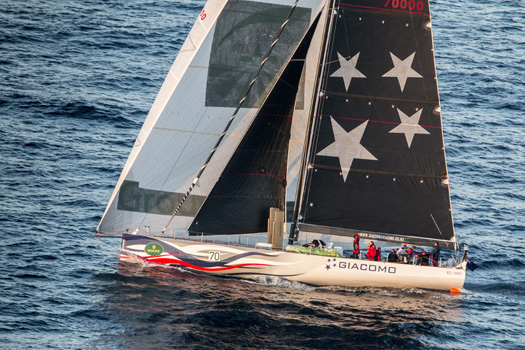
The Volvo 70s may have been developed for big winds in open water, but the former Groupama, now racing for New Zealand as Giacomo, has shown she can hang in when the breezes are light. Photo: Rolex/Carlo Borlenghi
Through the first night, the wind went light, and things were further turned on their head by ace navigator Stan Honey taking Perpetual LOYAL well to the east, which did her a lot of good. By morning they'd worked out an eleven mile lead on Wild Oats, but through the second day of light winds, Wild Oats ground down the big black boat, and as they crossed Bass Strait yesterday evening it was the old dog for the long road, Wild Oats still in the lead and hoping to have the advantage of an afternoon/evening arrival up the Derwent to Hobart before tonight's freshening northerly is replaced by southwest to west winds which could reach gale force, stacking the odds against the little fellows.
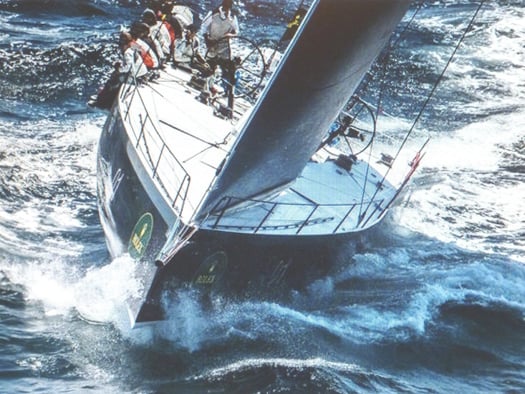
By comparison with some of the boat shapes racing to Hobart, Matt Allen's 60ft Ichi Ban with Gordon Maguire on the helm looks almost traditional. Photo: Rolex/Carlo Borlenghi
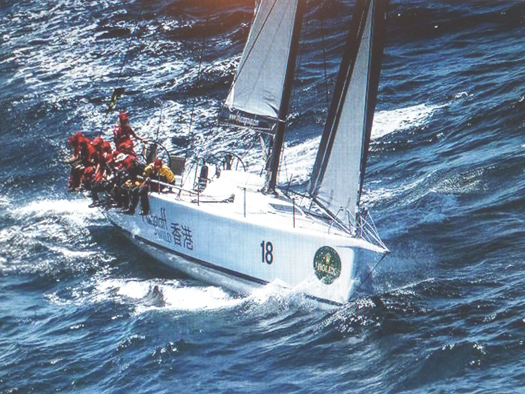
With the renowned Adrienne Cahalan as navigator, the 55ft Wedgetail is in with a shout. Photo: Rolex/Carlo Borlenghi
But meanwhile the top Irish hope, Gordon Maguire with Matt Allen's 60ft Ichi Ban , has been hanging in very nicely and things could fall sweetly their way. That said, while the 60ft Ichi Ban has been staying on the tails of the big boats ahead, not so far astern is the next size group with the lead held by Bill Wild's Reichel Pugh 55 Wedgetail. Formerly Yendys, this is one of Australia's proven all rounders. And for this first race to Hobart under the Wild command, Wedgetail's navigator is Adrienne Cahalan, who is renowned for seeing skippers on to the Hobart podium. But then, she was born in Offaly, and that makes all things possible.
Mathews and Kenefick Onboard Germany's 'AOC Rockall' for Middle Sea Race
Although there are no Irish boats at least two Irish crew are participating in Saturday's record breaking Rolex Middle Sea Race from Malta.
Dun Laoghaire navigator Brian Mathews, who narrowly misseed out on an international victory in the Dragon fleet with Martin Byrne in Cannes last month is sailing with Crosshaven's David Kenefick on board the Ex-'Rosie' 36 footer, now the German Registered AOC Rockall racing in IRC class four.
A record has been broken even before the start of the Race say the organisers. Days before final registration for this year's event, entries have risen to a record breaking 81 and there are still a few days to go before the last entry can be accepted.
New entries from Italy, Serbia, Slovenia and the UK have pushed the numbers up to 80, three more than the previous record of 77 in 2008.
"We can accept late entries up until 17th October and we do expect one or two more, said Georges Bonello Dupuis, Commodore of the Royal Malta Yacht Club. As it is, entries for this year are incredible and we are really looking forward to seeing them all berthed outside the Club; the place will be buzzing," he added.
A handful of boats are here, including previous RMSR line honours and overall winner, Alegre together with the back to back winner of the Rolex Fastnet, Ran 2.
Other arrivals include the UK Swan 57 Yellowdrama who'll be fighting for the new Nautor Swan Cup, Echo, Doppelbock (Germany & UK) and Filando and Tyke from Italy. Filando's 14-man crew come to Malta for the first time to take part in a race that they consider "the best offshore regatta in the Mediterranean."
Many of the entries will arrive this weekend, including the brand new 85 foot Nautor Swan ,Berenice from Italy. While good weather over the weekend will ease the passage of arriving yachts, Mr Bonello Dupuis cautioned, "I expect one or two might have problems making their way down to Malta, but fingers crossed that everyone arrives safely; they will certainly receive a warm welcome."
The Rolex Middle Sea Race is organised by the Royal Malta Yacht Club in association with the Royal Ocean Racing Club (RORC) and has been sponsored by Rolex since 2002.




























